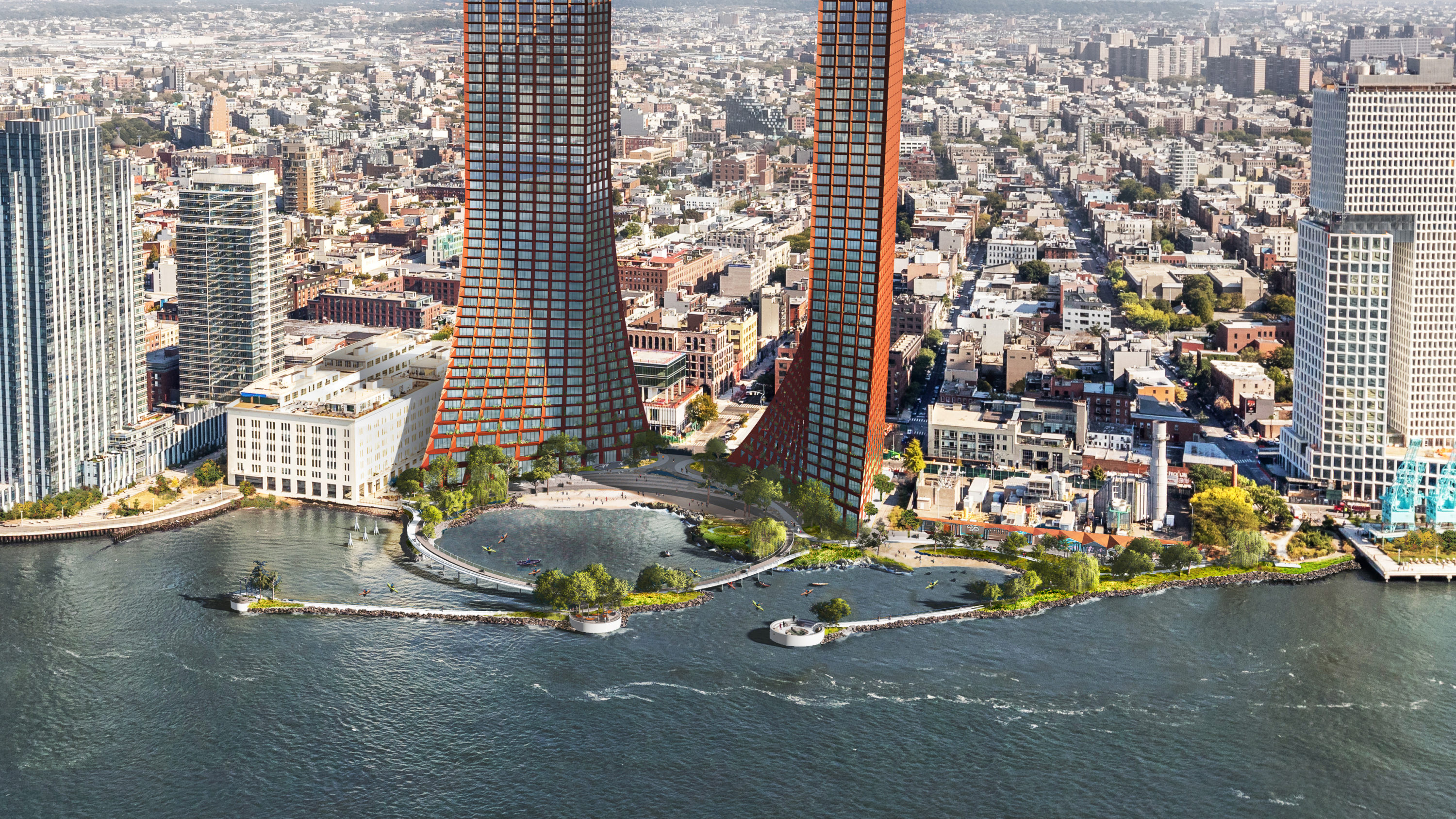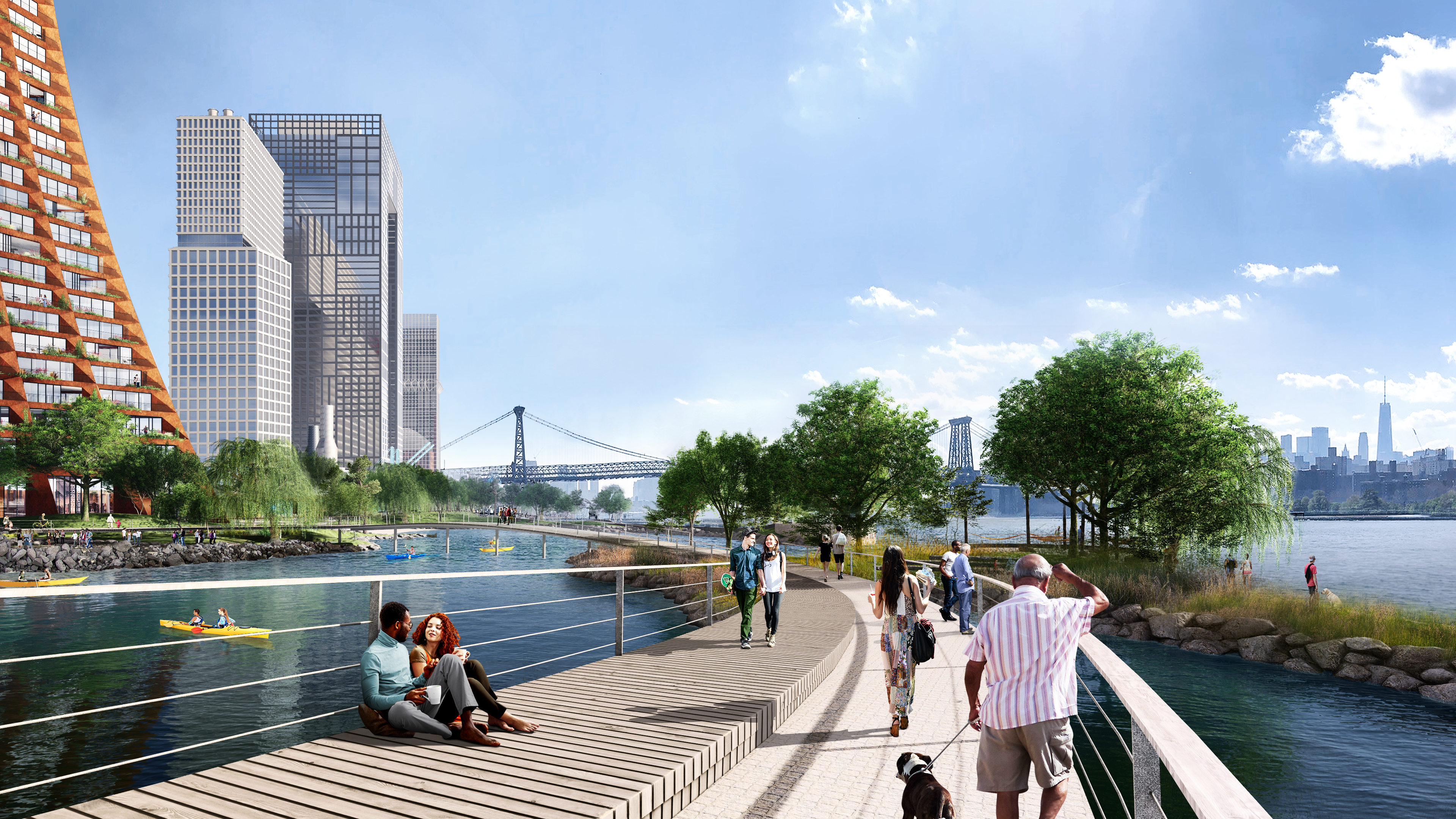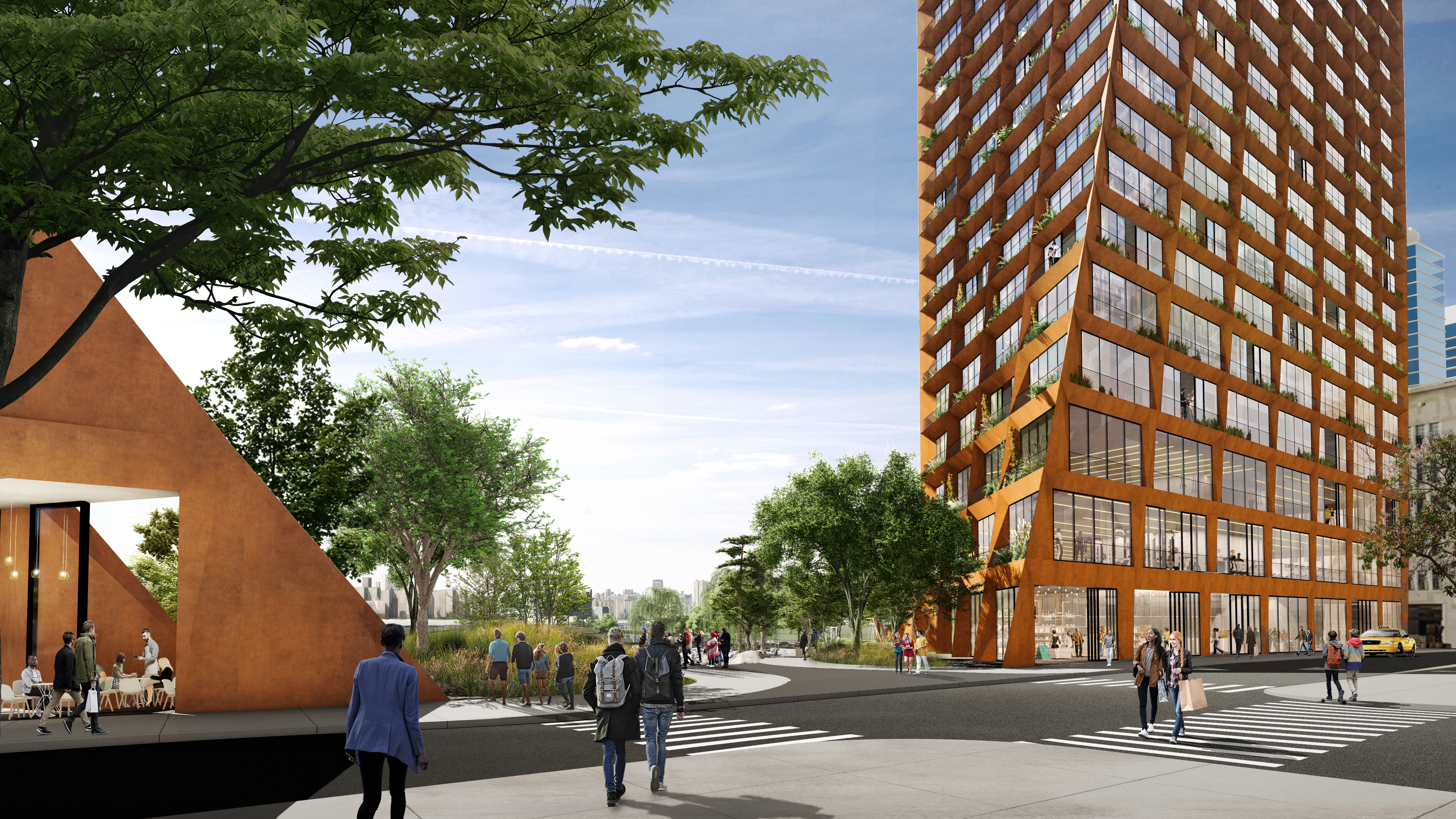
Skyscrapers, beaches and tidal pools: Two Trees reveals plan for Williamsburg waterfront

Two Trees Management, the developer of the mammoth Domino Sugar Refinery site, is expanding its dominance of the Williamsburg waterfront with the $150 million purchase of a nearby site from Con Edison, where some neighbors oppose any residential development.
Two Trees, the Walentas family’s real estate firm, unveiled its plans on Thursday for the River Street project, which it plans to build on the property it just bought from Con Edison. The project includes two towers with 1,000 apartments, 250 of which will be affordable units for lower-income tenants, and a water-centric park with a public beach and natural habitats such as a salt marsh, freshwater wetland and tidal pools.
Two Trees must get the River Street site rezoned in order to do residential development, but it faces opposition from neighborhood residents who started mobilizing several months ago, before the identity of the purchaser of the property became public knowledge.
The property is on the East River shoreline. It includes lots at 87 River St. and 105 River St., which are located on either side of Metropolitan Avenue, and a strip of land at 4 North First St. The 3.5-acre site is Con Edison North First Street Terminal’s decommissioned No. 6 fuel oil storage complex. The fuel tanks have been removed.
Affordable housing, retail and offices
One of the apartment buildings will be 600 feet tall, and the other will be 650 feet tall, Two Trees Principal Jed Walentas told reporters on Thursday. Those heights are the equivalent of 60 stories and 65 stories respectively. There will be a YMCA with a swimming pool in the base of one of the apartment buildings.

Architecture firm Bjarke Ingels Group designed the towers. The firm’s notable New York City designs include the XI / The Eleventh, which consists of a pair of modern twisting towers on 11th Avenue between West 17th and West 18th streets in Manhattan. The architects also proposed a concept for the BQE overhaul that would expand Brooklyn Bridge Park to the Brooklyn Heights Promenade.
The income levels for River Street’s affordable apartments will be negotiated, but will likely be a mix of units for tenants with incomes at 40 and 60 percent of area median income, Walentas said.
AMI is the formula used to determine income requirements for affordable housing. An individual at 40 percent of AMI earns $29,880 per year; an individual at 60 percent of AMI earns $44,820 per year.
The affordable housing is a requirement of the mandatory inclusionary housing program, a de Blasio administration initiative to spur construction of below-market-rate housing.
Walentas mentioned another option developers have for constructing affordable housing, which is to price 30 percent of the project’s total units for people who earn 130 percent AMI. An individual at that income level earns $97,110 per year.
He said Two Trees would not consider that option because there was “tremendous pushback” from people in many communities against that level of affordability.
“We heard loud and clear that that’s not what they’re looking for,” he said.
The River Street Waterfront Master Plan also calls for 30,000 square feet of space for small retailers and 57,000 square feet of office space.
A vision for a resilient, recreational waterfront
The planned park, devised by landscape architectural firm James Corner Field Operations, is composed of 2.9 acres of dry land plus a 3-acre area in the water that’s protected by breakwaters. The company previously designed Domino Park, which Two Trees built as part of the 11-acre residential and office complex it’s developing on the site of the former Domino sugar factory. It also designed the High Line in Manhattan.

Two Trees is building River Street’s park to fill the gap in a string of Williamsburg shoreline public spaces that extends from Domino Park to Bushwick Inlet Park.
There will be nature trails on walkways that extend out into the river with an outdoor tidal classroom at the end of one trail. The other trail will have a picnic and hammock grove and a “bird hide,” which is a shelter for observing birds and other wildlife.
Plans also include a circular boardwalk, an amphitheater and community kiosks that the developer envisions being used for kayak rentals and other amenities.
Activities for park-goers will include boating, fishing, exploring tidal pools and potentially swimming in the future. The East River is the cleanest it has been in a century, James Corner Field Operations Senior Principal Lisa Switkin told reporters.
Because the park will have a “softer shoreline” instead of a concrete barrier, it will be resilient after storms, she said.
Since the planned park extends into the river, the developer requires approval of the state Department of Environmental Conservation and the U.S. Army Corps of Engineers, she said.

Opposition is already taking shape
In March, a group called Friends of the Northside Waterfront, which later changed its name to Sustainable Williamsburg, launched an online petition calling on Community Board 1 to reject any residential rezoning of the Con Edison site, the Greenpoint Post reported.
It’s currently zoned for manufacturing and commercial use, which means that buildings with office, light manufacturing and retail space can be constructed as of right.
The petition now has nearly 1,600 signatures.
In May, members of Sustainable Williamsburg spoke out against the possible residential rezoning at a Community Board 1 meeting, the Greenpoint Post also reported.

When asked how Two Trees will respond to this opposition to rezoning, Walentas said the company will run “a very broad-based community engagement plan” with private and public sessions.
“Like all of our projects, we think that the more people know about them, the more they’ll like them, the more they’ll understand them and the more they’ll come to understand what choices we have and what our decision-making process was and how we arrived at certain solutions,” he said.
Two Trees doesn’t want to stick with the River Park site’s current zoning because industrial uses “make less and less sense on the urban waterfront” and parks, housing, schools and shops make more sense, Walentas said.
“And from a density standpoint, the world gets a lot of public good from density,” Walentas said. “Just like we demonstrated at Domino, without any public money, by using density as a value-creation tool we created hundreds of millions of dollars in public good between the park that we built and all the affordable housing that we created.”
Two Trees’ goal is to complete a Uniform Land Use Review Procedure — or ULURP — for rezoning River Street in the next two years, before Mayor Bill de Blasio leaves office, Walentas told reporters. After that, he expects the project’s construction to take five years. Two Trees will build one of the apartment towers and the park first, then construct the second apartment tower, Walentas said.
Two Trees can expect to encounter opposition from Sustainable Williamsburg during the ULURP process.

“What’s already being built on the Williamsburg shoreline is proving to be a strain on the infrastructure and has significant impact on the texture and the dynamic of the neighborhood,” Matt Emmi, a Sustainable Williamsburg member, told the Brooklyn Eagle on Thursday.
Just one subway line serves the waterfront area, and its one south-bound street is congested, said Emmi, who has lived in Williamsburg for 10 years.
This is an ideal moment for Two Trees to seek rezoning for the Con Edison site, Emmi said.
“Nobody has earned the good will of the neighborhood like Two Trees,” he said. Thanks to its construction of Domino Park, which is universally loved, Two Trees currently enjoys “strong good will” in the neighborhood, according to Emmi.
Two Trees paid a high price for the property because it anticipated it would be able to get the site rezoned for residential use, Emmi said.
“Whether they bully or charm the neighborhood — and I personally appreciate that it seems that they’re taking the ‘charm’ approach — I still don’t think it’s right,” Emmi said. “They have the audacity to pay this much for a piece of land with the confidence that they will have the zoning overturned. What’s the point of the zoning if it can just ultimately always be overturned and changed?”
Follow reporter Lore Croghan on Twitter.
Leave a Comment
Leave a Comment






I wish they would just take advantage of the existing zoning and build a factory there. Maybe a tannery or a steel mill.
What happened to the third tree?
This is a joke. The entire presentation was one long attempt to hide the obsene scale of this project. The existing zoning should be kept as is. Please sign the petition against this project here: https://www.change.org/p/community-board-1-say-no-to-rezoning-con-ed-n-3rd-kent-to-add-1000-s-of-new-residents-to-williamsburg-amidst-a-transportation-crisis/psf/share?source_location=signed_interrupt